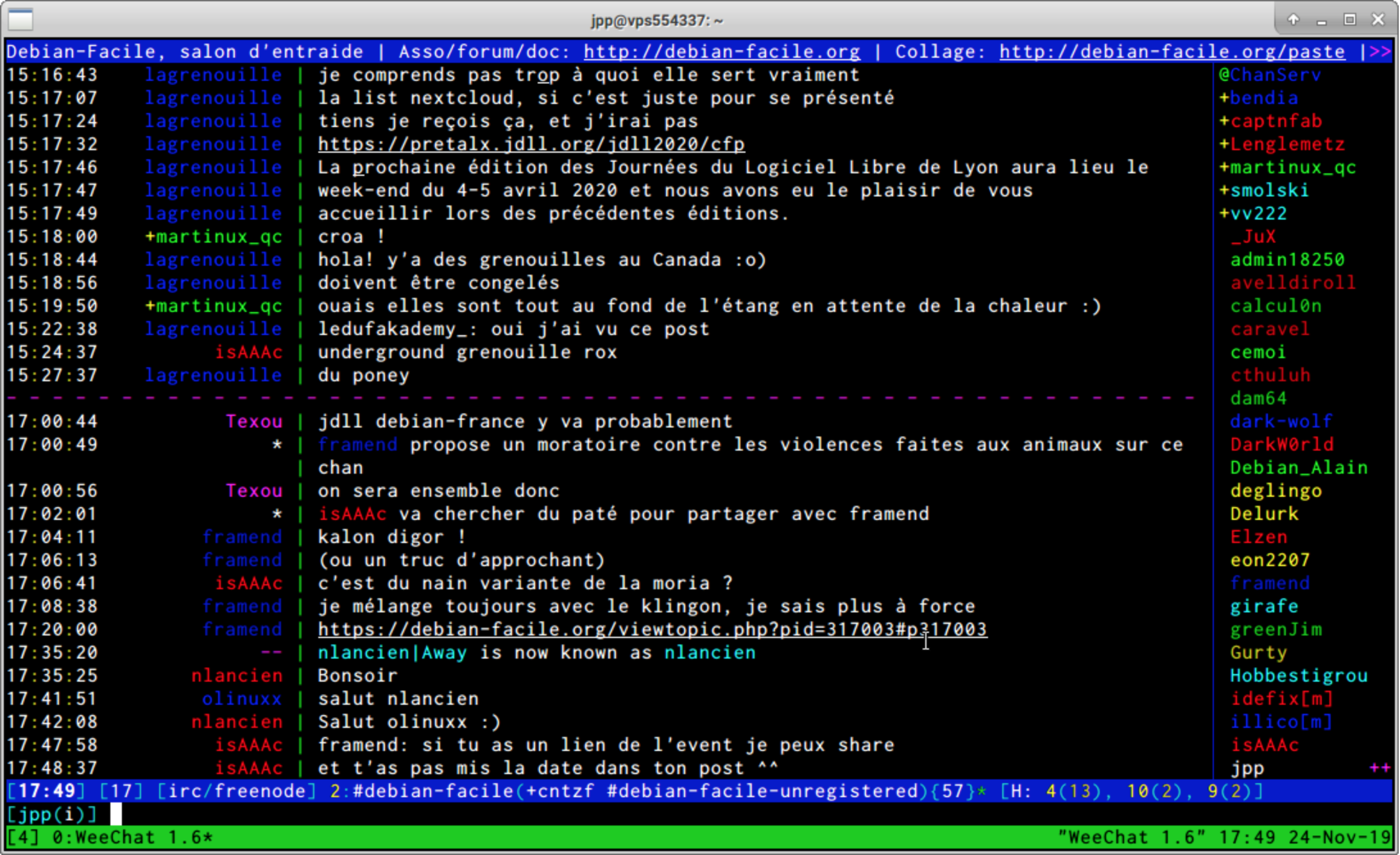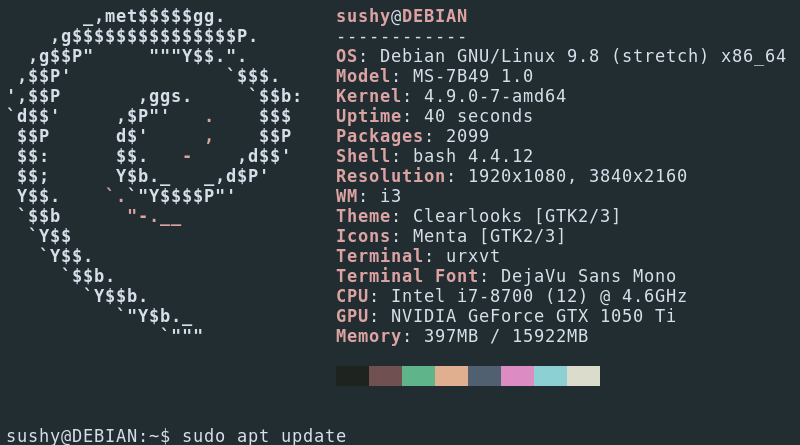Table des matières
Terminal Urxvt
- Objet : urxvt, abréviation de rxvt-unicode, est un émulateur de terminal pour l'environnement graphique X Window System.
- Niveau requis :
- Commentaires : Raccourcis clavier.
- Suivi :
- Création par Jean-Pierre Pinson 18/03/2019
- Testé par Jean-Pierre Pinson & SuShY le <18/03/2019>
- Commentaires sur le forum : Lien vers le forum concernant ce tuto 1)
Introduction
urxvt ( abréviation de rxvt-unicode ), est un émulateur de terminal.
Ce terminal virtuel est un clone de rxvt écrit par Marc Lehmann.
rxvt est un logiciel libre distribué selon les termes de la licence GNU GPL.
rxvt-unicode se veut très léger et facilement configurable, et permet de démarrer en démon.
En controverse, ce logiciel possède de nombreuses fonctionnalités intéressantes, voire inédites, comme :
- l'affichage de différentes polices en même temps,
- la transparence ou encore les extensions perl.
- Il rend aussi les URL cliquables.
( Extrait de Wikipédia)
installation
apt-get install rxvt-unicode
pour lancer urxvt
urxvt
Raccourcis clavier Urxvt
⇧ Shift + souris pour sélectionner
Ctrl + Alt + C pour copier
⇧ Shift + Inser pour coller dans le navigateur internet
Ctrl + Alt + V pour coller dans le terminal
Ctrl + D est un équivalent d'exit pour le shell
Capture d'écran du Terminal Urxvt
Configuration
On peut aussi configurer son terminal en créant un nouveau fichier :
nano /home/user/.Xresources
Par exemple contenant ce script :
- Urxvt
!~/.Xresources config !-------------------- {{!_____________ !urxvt config !____________ !Base de config locales etc... URxvt.imLocale: fr_FR.UTF-8 URxvt.background: #1B1B1B URxvt.foreground: #CFCFCF URxvt.cursorColor: #9FF766 URxvt.tintColor: #999999 URxvt.scrollBar: false URxvt.scrollBar_right: false !curseur clignotant URxvt.cursorBlink: true !URL launcher URxvt.url-launcher: firefox URxvt.matcher.button: 1 URxvt.perl-ext: default,matcher !Onglets URxvt.perl-ext-common: default,tabbed !yankables URL's URxvt.perl-ext: default,url-select URxvt.keysym.M-u: perl:url-select:select_next URxvt.url-select.launcher: /usr/bin/xdg-open URxvt.url-select.underline: true !URxvt.urlLauncher: luakit !Fonts !URxvt.font: Inter UI, Material Design Icons 9 !URxvt.font: xft:noto-mono:size=9 URxvt.font: -*-terminus-medium-*-*-*-14-*-*-*-*-*-*-* !link URxvt.colorUL: #4E9A06 ! black URxvt.color0: #2E3436 URxvt.color8: #555753 ! red URxvt.color1: #A63A0A URxvt.color9: #960B00 ! green URxvt.color2: #4E9A06 URxvt.color10: #8AE234 ! yellow URxvt.color3: #C4A000 URxvt.color11: #FCE94F ! blue URxvt.color4: #657b83 URxvt.color12: #268bd2 ! purple URxvt.color5: #75507B URxvt.color13: #AD7FA8 ! cyan URxvt.color6: #06989A URxvt.color14: #34E2E2 ! white URxvt.color7: #D3D7CF URxvt.color15: #EEEEEC ! !_________________________ !fin de config URxvt oué! !_________________________ !_________________________
xrdb .Xresources
De Framend communiqué en direct sur irc. ![]()
Utilisation d’onglets
Selon la configuration publiée ici, votre urxvt devrait faire apparaître une barre avec le mot NEW dedans.
Si vous cliquez sur le mot NEW, un nouvel onglet apparaît sous la forme d’un nouveau chiffre. La manipulation est aussi possible en appuyant simultanément sur la touche [Shift]+[Flèche bas].
Pour passez d’un terminal à l’autre, appuyez sur la touche [Shift]+[Flèche droite] ou bien la flèche gauche.
Pour déplacer un terminal, aller dessus (avec les raccourcis cités ci-avant), puis pressez la touche [Ctrl], laissez appuyez, puis utilisez les touches [Flèche gauche] et/ou [Flèche droite] pour migrer le terminal à l’endroit choisi.
Pour fermer un terminal, je n’ai trouvé d’autre raccourci que [Ctrl]+[D]. Si vous en connaissez d’autres, n’hésitez pas à me contacter 😉
Et maintenant, celui de Sushy même canal que le précédent :
- URxvt SuShY
! =================== ! urxvt ! =================== URxvt*scrollBar: true URxvt*scrollBar_right: true URxvt*scrollBar_floating: true URxvt*letterSpace: 0 URxvt.internalBorder: 10 URxvt*font: xft:DejaVu Sans Mono:regular:size=13 URxvt*boldFont: xft:DejaVu Sans Mono:bold:size=13 URxvt*cursorBlink: true URxvt.iso14755: false URxvt*utf8: true URxvt.keysym.C-equal: resize-font:bigger URxvt.keysym.C-parenright: resize-font:smaller URxvt.perl-ext-common: default,matcher URxvt.url-launcher: chromium URxvt.matcher.button: 3 ! URxvt*perl-ext: matcher ! URxvt.perl-ext-common: default ! Prise en charge des onglets ! shift+bas ou clic sur NEW= ouvrir nouvel onglet, ! shift + fleche gauche/droite=navigation dans les onglets. ! ctrl + fleche gauche/droite= deplacement onglet ! ctrl+d ou taper exit = fermer onglet/terminal ! black + red ! !urxvt*color0: #3f3f3f urxvt*color0: #1E2320 urxvt*color1: #705050 ! ! green + yellow urxvt*color2: #60b48a urxvt*color3: #dfaf8f ! ! blue + purple urxvt*color4: #506070 urxvt*color5: #dc8cc3 ! ! cyan + white urxvt*color6: #8cd0d3 urxvt*color7: #dcdccc ! ! bright-black + bright-red urxvt*color8: #709080 urxvt*color9: #dca3a3 ! ! bright-green + bright-yellow urxvt*color10: #c3bf9f urxvt*color11: #f0dfaf ! ! bright-blue + bright-purple urxvt*color12: #94bff3 urxvt*color13: #ec93d3 ! ! bright-cyan + bright-white urxvt*color14: #94bff3 urxvt*color15: #ffffff !!!URxvt*color0: #101010 !!!URxvt*color1: #f13a21 !!!URxvt*color2: #93f91d !!!URxvt*color3: #ffd00a !!!URxvt*color4: #004f9e !!!URxvt*color5: #ec0048 !!!URxvt*color6: #2aa7e7 !!!URxvt*color7: #f2f2f2 !!!URxvt*color8: #1d202f !!!URxvt*color9: #ff361e !!!URxvt*color10: #ffc005 !!!URxvt*color11: #93ff00 !!!URxvt*color12: #0071ff !!!URxvt*color13: #ef0051 !!!URxvt*color14: #4bb8fd !!!!URxvt*color15: #a020f0
- URxvt SuShY
URxvt.perl-ext-common: default,matcher URxvt.url-launcher: chromium URxvt.matcher.button: 3
Et le résultat avec
screenfetch
, est…
Artistique, n'est-il pas ? ![]()
Les URL cliquables
Pour se faire on édite le fichier ~/.Xresources comme suivant, en ajoutant ces trois lignes ci-dessous à la suite de la configuration dédié à URxvt :
URxvt.perl-ext-common: default,matcher URxvt.url-launcher: /usr/bin/xdg-open URxvt.matcher.button: 1
xrdb .Xresources
Les bips sonores
Il est possible d'exécuter une commande lorsque le terminale sonne. Et pour se faire, l'extension bell-command doit être activé dans le fichier ~/.Xresources :
URxvt.perl-ext-common: ...,bell-command,...
L'exemple suivant emploie la commande aplay d'ALSA pour jouer par exemple un fichier .wav :
URxvt.bell-command: aplay /home/utilisateur/beepbeep.wav
xrdb .Xresources
Divers liens
http://software.schmorp.de/pkg/rxvt-unicode.html
https://wiki.archlinux.org/title/Rxvt-unicode/Tips_and_tricks

